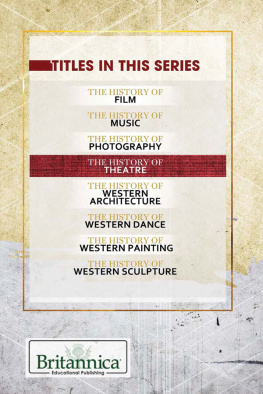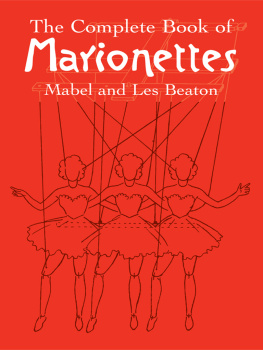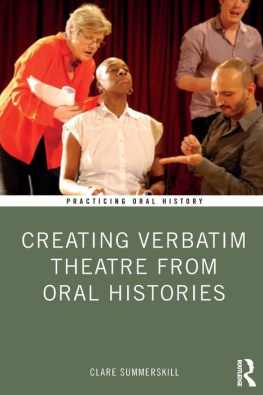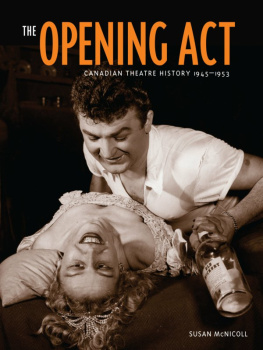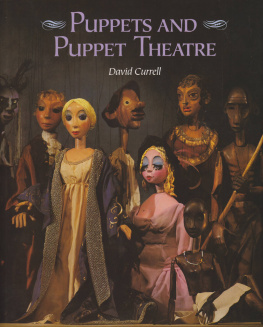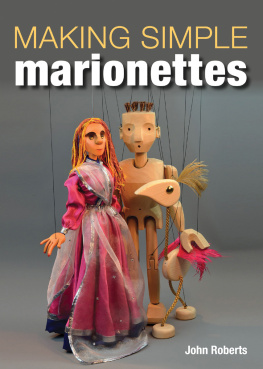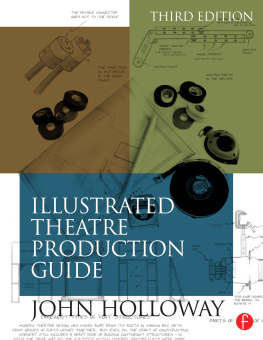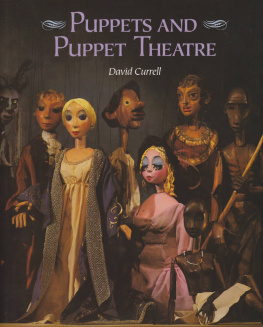Chapter One
*
As far as I can see, the whole essence of a marionette theatre lies in its portability and adaptability. You want to be able to give shows wherever you like, at a moments notice. You dont want anything of the nature of a permanent building. Besides (as I realised in a moment of temporary sanity), when the theatre is up in your house and all the members of the family and of the domestic staff are engaged in rehearsals, things have a habit of spreading from room to room until all your meals are being eaten in restaurants and you have to sleep in the garden. You simply have to be able to pack the thing away and forget it sometimes, in order to do some work and restore discipline among the children.
All this presupposes a theatre which can be taken to pieces, and which can be erected in any ordinary room. The ideal house for a marionette theatre is one with a double drawing-room with dividing doors which either fold right back or can be taken away. In this case the dividing doorway constitutes the proscenium. I realised this right from the start; but my house has no double drawing-room, and although I offered to move, Kathleen would not hear of my sacrificing the remainder of my lease, because, as she pointed out, we should not always be certain of having dividing doors wherever we might perform. So we must have a theatre which was not dependent on this architectural survival.
My drawing-room is fourteen feet wide, and at one end is a deep bay. We decided that that end of the room would be the right place for the theatre, and to work to those measurementsand we have found that what we eventually constructed is well adapted for performances anywhere. On each side of the stage there must be a wing for those assistants who are engaged in looking after the curtain and the gramophone and the scenic effects. A floor-space three feet square seems to be the minimum one can allot for this, so that the two wings take up six feet of the fourteen feet width. Then you must be able to get into and out of the theatre from the front; and I (full of memories of what goes on in a real theatre in the wings at a dress rehearsal) insisted that this should be possible at either side. Two free spaces of eighteen inches together make up three feet, and so you have arrived at the width of your stage, upon which everything else necessarily depends. That width is fourteen feet minus six minus three, making five feet. That decides the size of your puppets, the sort of performance you are going to produce and everything else.
Now, even to anyone who has never worked a puppet, it is obvious that if the puppeteer is to be behind the stage (and not on a framework above it), the depth of the stage, from footlights to backcloth, cannot usefully be greater than the full stretch of the human armthree feet at most. So that the stage is five feet wide and three feet deep. As to its height above the floor, opinion differs. At first sight the higher the better for the audiences sake. But puppeteers like to stand above their puppets, and experience shows that the more expert the puppeteer, the higher he wants to be. So that if the stage is four feet high, say, there must be a castle for the puppeteers six feet high, and the puppeteers will be bumping their heads on the ceiling. Moreover, if the audiences eyes are on a level with the stage, they have more chance of looking up under the proscenium arch (unless this is unnaturally low), and that would never do.
Everything considered, it is better to have a low stage. Experience shows that in a fair-sized room, and even in a small hall, an audience seated in chairs in three or four rows have quite a good view of a stage a foot high. Actually it is possible, and from some aspects desirable, to have the stage actually on the floor, because the stage, a piece of plywood reinforced with battens, five feet by three, is the clumsiest item in the whole theatre (from the point of view of portability). But on the other hand, if the stage is raised a bit, the space beneath is very convenient for concealing electric lighting wires and for storing properties during a performance and so on, while its edges can carry the footlights in a way which saves a whole lot of trouble as compared with any other method. In my opinion the balance of convenience inclines towards a stage a foot highjust a sheet of plywood supported on detachable frames at each end with a pile of books to hold it up in the middle. Books are a legitimate device, because they can be found wherever you happen to perform, and they are convenient because it is easy with them to make a pillar just the right height.
That settles the stage, thank goodness, and it only remains to construct the theatre. Mine has never varied at all from its original design; the front of it is composed of two collapsible clothes-horsesI had a terrible business explaining a clothes-horse to a generation accustomed to airing cupboards. Take two battens, nine feet long and two inches square in section. Join them by two similar battens, each two feet six long, at either end, by the aid of dowels. This gives you an oblong frame. Make another oblong frame exactly the same size. Now on one long member of one frame put two galvanised iron eyes, and on one long member of the other frame put two galvanised iron hooks in corresponding positions; put the hooks through the eyes, and your two frames are bolted together, and they will stand upright when placed at an angle to each other; one frame faces the audience and the other guards the flank of the theatre from prying eyes.
Now make two more identical frames for the other side of the stage. When the two wings are standing up, by the aid of more hooks and eyes you join them by a piece of reinforced plywood six inches wide, at a height about three feet above the stage and by another at floor level. You have now only to pin curtains over the whole affair with drawing-pins and the front of the theatre is complete.
This may sound a very unreliable contraption. You have to take my word for it that it is not. To this day we are still occasionally tormented with the idea that the whole front may fall forward, revealing everything inside, but it never has and I dont think it ever will. To set our minds at rest we tie strings from the top cross-members to the window-frames over the puppeteers heads, but they are unnecessary. The strings, however, serve a useful purpose from another point of view, in that they carry a horizontal sheet which cuts off the light from the theatre and prevents revealing shadows appearing on the ceilinga very necessary point.
As a matter of fact it is the drawing-pins and the curtains which give the whole thing solidity. It sounds chancy, but it is not, really. Fifty drawing-pins, well driven home, will fix anything. And the framework can be dismounted in a moment and carried anywhere, although the four nine-foot members are, after the stage, the most unwieldy items in the whole theatre. I have dallied with the idea of making them jointed, but I really do not think the gain in portability is balanced by the increased complexity of construction. But I would like to add the hint that it is as well to mark every member with its place in the ensemble. It reduces very much the time necessary for construction, and, later on, if the wood begins to warp a bit as wood may well do, the theatre can always be put together in that particular way even if it cannot be in any other.
To complete the front of the theatre the needle-woman of the company must now set to work to make a proscenium arch (the picture shows what a pretty one we have) and the act drop-curtains. And here and now I must lay it down definitely that it is vitally important to have an efficient act drop. The curtains must slide across quietly, smoothly and slowly. It is easy enough to buy curtain-runners which will do thisyou need a brass rail carrying a lot of little wheels with hooks; and everything which moves must be thoroughly and regularly lubricated. The whole mechanism can be bought at an upholsterers, including the strings and pulleys which enable the two curtains to be opened and shut from one side simultaneously. Everybody can work out how this is done, although it would take me a couple of pages with diagrams to explain it.
Next page



